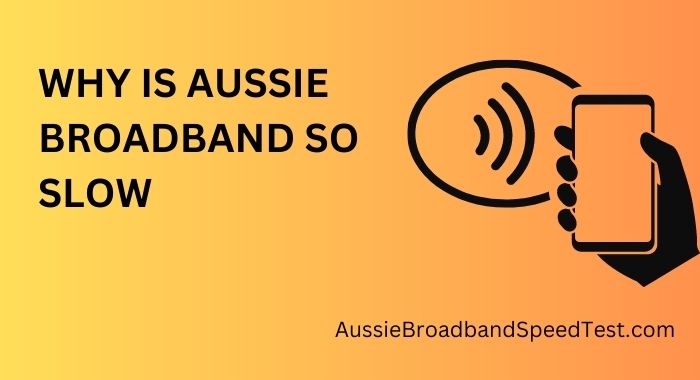In our increasingly digital age, where everything from work to entertainment relies on a stable and fast internet connection, slow broadband can be a frustrating experience. Aussie Broadband, a well-known internet service provider in Australia, has garnered both praise and criticism for its service quality.
Various factors influence internet speed, including the type of connection, network congestion, hardware quality, and the distance between your device and the service provider’s servers. Additionally, latency and ping, which denote the delay in data transmission and response time, respectively, play crucial roles in determining the quality of your online experience.
Factors Affecting Aussie Broadband Speeds
Network congestion often leads to reduced internet speeds during peak usage hours, such as evenings when many users are active simultaneously. The distance between your location and the nearest exchange point also plays a pivotal role; greater distances can result in slower speeds due to signal degradation. Furthermore, the quality of infrastructure, including cables and equipment, impacts the reliability and speed of your broadband connection.
The NBN Rollout
The National Broadband Network (NBN) initiative aimed to provide faster and more reliable internet to all Australians. However, the rollout faced challenges ranging from technical issues to disputes over technology choices. Aussie Broadband’s speed has been affected by the NBN rollout due to the complexities involved in transitioning to the new infrastructure while ensuring uninterrupted service.
Aussie Broadband’s Approach to Speed
Aussie Broadband acknowledges the significance of speed for customer satisfaction. The company employs various strategies to address speed concerns. By effectively managing bandwidth allocation, Aussie Broadband aims to ensure consistent and optimal speeds for its customers. Moreover, the provider places a strong emphasis on customer support and technical assistance to troubleshoot and resolve speed-related issues promptly.
Comparing Aussie Broadband with Competitors
Conducting speed tests and comparing results with competitors offers insights into Aussie Broadband’s performance. Customer reviews and experiences also shed light on the quality of service. While the provider has received praise for its customer-centric approach, some users have reported speed issues during peak times. Aussie Broadband continues to innovate to enhance its speed offerings and minimize disparities.
The Importance of Regular Maintenance
Maintaining a high-speed broadband network requires regular upgrades to equipment and technology. By embracing the latest advancements, service providers like Aussie Broadband can ensure that their networks remain capable of handling increasing data demands. Proactive monitoring of network performance is crucial to detect and address potential issues before they impact users’ experiences.
Government Regulations and Policies
Government regulations and policies can significantly influence the broadband landscape. Aussie Broadband operates within the framework set by these regulations, which can affect aspects such as pricing, service quality, and speed. Calls for improved policies and regulations that promote healthy competition and ensure equitable access to high-speed internet are essential to address speed-related challenges.
Improving Aussie Broadband Speeds
To address slow internet speeds, Aussie Broadband must invest in infrastructure upgrades. Collaborative efforts with the NBN and other stakeholders can lead to comprehensive improvements. Incorporating advanced technologies such as fiber optics and 5G can revolutionize the broadband experience by providing faster and more reliable connections.
Customer Empowerment and Education
Empowering customers with knowledge about optimizing their internet speeds is crucial. By educating users about factors that impact speed and offering practical tips, Aussie Broadband can foster a community of informed users who actively contribute to their own speed enhancement. Awareness of bandwidth-intensive activities and their impact on overall speed is also essential for a seamless online experience.
The Role of Streaming and Online Activities
The surge in streaming services, online gaming, video conferencing, and other bandwidth-intensive activities has heightened the demand for faster broadband. Streaming, in particular, requires substantial bandwidth to deliver high-quality content without buffering. Balancing speed requirements for different online activities ensures that users can enjoy a smooth experience across various applications.
Addressing Common Misconceptions
It’s common for users to misunderstand the concept of “unlimited” data plans. These plans offer unlimited data usage but do not guarantee consistently high speeds at all times. It’s important to set realistic expectations about speed, considering factors like network congestion and infrastructure limitations. Understanding that internet speed can vary even within an unlimited plan helps manage user expectations.
Future Outlook for Aussie Broadband
Looking ahead, the future holds promising advancements in technology that can potentially revolutionize internet speed. As innovation continues, we can expect enhanced speed, reliability, and overall internet experience. Aussie Broadband’s commitment to progress and customer satisfaction positions it well to embrace these advancements and offer cutting-edge speed solutions.
Conclusion
In conclusion, the question of why Aussie Broadband experiences slow speeds is multifaceted. Factors such as network congestion, infrastructure quality, and the NBN rollout play interconnected roles. However, it’s important to recognize that Aussie Broadband is actively addressing these challenges through bandwidth management, customer support, and collaboration with industry stakeholders. As technology advances and policies evolve, there’s optimism for a future where Aussie Broadband delivers even faster and more reliable internet speeds.
FAQs
- Why is my Aussie Broadband connection slower in the evenings?
- Evening hours often witness high user activity, leading to network congestion and reduced speeds.
- Can I improve my Aussie Broadband speed on my own?
- Yes, optimizing your setup, using a wired connection, and avoiding peak usage times can help enhance speeds.
- Is NBN the only factor affecting my internet speed?
- No, while NBN is a significant factor, other elements like distance from exchange points and infrastructure quality matter too.
- What is the average internet speed in Australia?
- The average speed varies but hovers around 50-60 Mbps for downloads.
- Does upgrading my plan guarantee faster speeds?
- While upgrading can improve speeds, factors like network congestion and infrastructure quality still influence performance.
- Are there any alternative broadband options to consider?
- Yes, exploring different providers and technologies can offer diverse speed options.
- How can I test my Aussie Broadband speed accurately?
- Use online speed testing tools during different times of the day for a comprehensive evaluation.
- What can I do if my Aussie Broadband speed doesn’t improve?
- Contact Aussie Broadband’s customer support for assistance and troubleshooting steps.



